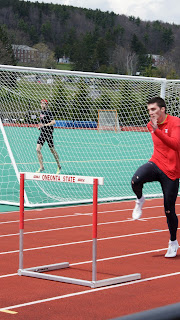1. Make a photo about one part of your partner's body.
The background is light and blurry, so she stands out more.
2. Photograph your partner in motion.
She started jogging in place - the blurriness in her arm is interesting.
3. Take a posed portrait of your partner.
I'm happy with the fact that I figured out how to get her face in focus and make the background look blurry.
4. Take an unposed documentary photo of your partner.
I like how you can see the guy in the background - it looks like he is moving quickly.
5. Photograph your subject in any way you want. Be creative.
I like this one because I decided to take it at a different angle than all of the other ones.
1. I didn’t feel uncomfortable being photographed at all. I think it’s because I worked with my partner a couple times in class, so I already kind of knew her. It helped that I knew what kinds of photos she had to take of me. The hardest part of being photographed this time was trying to figure out how to pose for the “unposed documentary photo.” I think some people might be uncomfortable with being photographed up close because the photographer/camera gets into their personal space.
2. I think if you’re taking pictures of someone and he/she feels uncomfortable, you should explain to him/her what project/assignment you are working on so he/she can understand what you’re doing and why. You could also talk to him/her before you take photographs so he/she can become acquainted with you. It also might be helpful if you show him/her what shots you took so he/she can see your progress and work. It would be a good idea to see if he/she is uncomfortable with posing a certain way.


























































